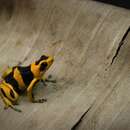Description
provided by AmphibiaWeb articles
Ranitomeya summersi is a large species of Ranitomeya, with adults reaching 20.4 mm SVL. Adults have a black body with conspicuous orange ‘rings’ encircling the body and outlining the top of the head. An orange line is also present running along the dorsal surface of each limb. Ventral coloration is black with irregular orange lines. Little variation has been documented in this species, although the dorsal orange markings are sometimes broken or have branching patterns.A stage 29 tadpole had a total length of 19.0 mm and body length of 7.6 mm. Body ovoid in dorsal view. On the mouth, jaw sheaths are serrate and lack indentations. White, rounded marginal papillae are present around posterior labium and lateral parts of anterior labium. Labial tooth row formula 2(2)/3. In life, tadpole was gray without any distinct markings.This species was long considered to be a morph of Ranitomeya fantastica (e.g. Silverstone 1975, Schulte 1999). Brown et al. (2008) provided morphological, genetic, and acoustic data which suggested this species was distinct enough to warrant full-species status.In 2011, the genus Dendrobates was subdivided into seven genera, including the new genus Ranitomeya by Brown et al (2011).
Distribution and Habitat
provided by AmphibiaWeb articles
This species occurs in the central Huallaga Canyon near the towns of Sauce and Chazuta in San Martin, Peru. This species appears to be primarily associated with premontane habitats, occurring up to 684 m elevation. Habitats tend to be relatively dry, with reduced rainfall between the months of June through September.
Life History, Abundance, Activity, and Special Behaviors
provided by AmphibiaWeb articles
Ranitomeya summersi is a diurnal, terrestrial species. Little is known about the breeding behavior, although adults can frequently be found in Dieffenbachia axils which contain water. Courtship and egg deposition take place in leaf litter. Clutches consist of 4-9 eggs. Tadpoles are transported by the male to water bodies in tree holes or Dieffenbachia axils. These frogs can be found in disturbed areas, and can be locally abundant, especially in habitats with high densities of Dieffenbachia.
Life History, Abundance, Activity, and Special Behaviors
provided by AmphibiaWeb articles
Much of this species’ potential habitat has been deforested, especially along Rio Huallaga and near the town of Sauce. This species has been smuggled for years, especially in the vicinity of Chazuta. Although R. summersi has not yet been officially evaluated as to population status, Brown et al. (2008) suggest this species be listed as Endangered (EN).
Relation to Humans
provided by AmphibiaWeb articles
Highly desired as a terrarium pet.
Ranitomeya summersi
provided by wikipedia EN
Ranitomeya summersi, sometimes referred to as Summers' poison frog,[1] is a species of poison dart frogs found in the central Huallaga River drainage and adjacent Cordillera Azul National Park in central Peru.[1][3] Before 2008, the species was considered a subspecies of Ranitomeya fantastica.[2] The IUCN considers it an endangered species because of limited habitat range, habitat loss, and collection for the pet trade.[1][4][5]
They lay their eggs primarily in Dieffenbachia plants and in holes in trees.[4]
Morphology
Ranitomeya summersi is one of the larger species of poison dart frogs. It has an orange and black banded pattern and a large snout to vent length. Males and females exhibit no sexual dimorphism in snout to vent length, exhibiting a range from 15.5 mm to 20.4 mm. This species possesses a black marking over the eyes extending past the tympanum giving them the appearance of a mask. The species is a Batesian mimicry of Ranitomeya Variabilis. While Ranitomeya imitator can copy the appearance of R. summersi, R. summersi can be distinguished from the imitator by its soft buzz call which can only be heard less than 1 m away, and its dark mask which covers the tympanum. In contrast the Ranitomeya imitator calls are much louder and can be heard form 5 m away.[2]
References
-
^ a b c d IUCN SSC Amphibian Specialist Group (2018). "Ranitomeya summersi". IUCN Red List of Threatened Species. 2018: e.T193430A89224207. doi:10.2305/IUCN.UK.2018-2.RLTS.T193430A89224207.en. Retrieved 19 November 2021.
-
^ a b c Brown, Jason L.; Twomey, Evan; Pepper, Mark; Rodriguez, Manuel Sanchez (16 July 2008). "Revision of the Ranitomeya fantastica species complex with description of two new species from Central Peru (Anura: Dendrobatidae)". Zootaxa. 1823: 1–24.
-
^ Frost, Darrel R. (2016). "Ranitomeya summersi Brown, Twomey, Pepper, and Sanchez-Rodriguez, 2008". Amphibian Species of the World: an Online Reference. Version 6.0. American Museum of Natural History. Retrieved 9 June 2016.
-
^ a b Twomey, Evan; Brown, Jason. "Ranitomeya summersi". Dendrobates.org. Retrieved 7 June 2016.
-
^ "Red list changes highlight threats from over-exploitation". TRAFFIC. 10 November 2011.

- license
- cc-by-sa-3.0
- copyright
- Wikipedia authors and editors
Ranitomeya summersi: Brief Summary
provided by wikipedia EN
Ranitomeya summersi, sometimes referred to as Summers' poison frog, is a species of poison dart frogs found in the central Huallaga River drainage and adjacent Cordillera Azul National Park in central Peru. Before 2008, the species was considered a subspecies of Ranitomeya fantastica. The IUCN considers it an endangered species because of limited habitat range, habitat loss, and collection for the pet trade.
They lay their eggs primarily in Dieffenbachia plants and in holes in trees.
- license
- cc-by-sa-3.0
- copyright
- Wikipedia authors and editors

